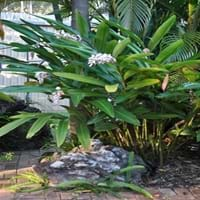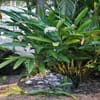Life Span
Perennial
Perennial
Type
Tender Perennial
Flowering Plants
Origin
Southeastern Asia, India, Melanesia, Micronesia
Asia, Europe
Types
Variegata Dwarf, Variegata Chinese Beauty
American Lily of the Valley, European Lily of the Valley, Japanese Lily of the valley.
Number of Varieties
Not Available
Habitat
Tropical regions
Banks, Broad-Leaved Forests, coppices, Dry and Young forest Heaths, Forest margins, Ridges, Rocky Ridges
USDA Hardiness Zone
8-15
4-8
Sunset Zone
H1, H2, 14, 15, 16, 17, 18, 19, 20, 21, 22, 23, 24
A1, A2, A3, H1, H2, 1a, 1b, 2a, 2b, 3a, 3b, 4, 5, 6, 7, 14, 15, 16, 17, 18, 19, 20
Habit
Clump-Forming
Mat-forming
Flower Color
White, Red, Light Pink
Pink, White
Flower Color Modifier
Multi-Color
Not Available
Fruit Color
Not Available
Not Available
Leaf Color in Spring
Dark Green
Dark Green
Leaf Color in Summer
Dark Green
Dark Green, Green
Leaf Color in Fall
Dark Green
Green, Yellow green
Leaf Color in Winter
Dark Green
Not Available
Leaf Shape
Lance shaped
Bell Shaped
Plant Season
Spring, Summer, Fall, Winter
Fall, Spring, Summer
Sunlight
Partial Sun, Partial shade
Part sun, Partial shade
Type of Soil
Loam, Sand
Moist, Well drained
The pH of Soil
Acidic, Neutral
Acidic, Neutral
Soil Drainage
Average
Not Available
Bloom Time
Late Spring, Early Summer, Summer
Late Spring, Spring
Tolerances
Drought
Not Available
Where to Plant?
Container, Ground, Pot
Container, Ground, Pot
How to Plant?
By dividing rhizomes, tubers
From Rhizomes, Seedlings
Plant Maintenance
Medium
Medium
Watering Requirements
Requires plenty of water during the growing season
Keep the ground moist but not water-logged, Requires a lot of watering, Water twice a day in the initial period, Water when soil is dry
In Summer
Lots of watering
Lots of watering
In Spring
Moderate
Moderate
In Winter
Average Water
Average Water
Soil pH
Acidic, Neutral
Acidic, Neutral
Soil Type
Loam, Sand
Moist, Well drained
Soil Drainage Capacity
Average
Not Available
Sun Exposure
Partial Sun, Partial shade
Part sun, Partial shade
Pruning
Cut off the flower stalks at the base of the plant, Remove dead leaves, Remove dead or diseased plant parts
Do not prune during shooting season, Prune after harvesting, Prune in late summer or fall, Prune to stimulate growth, Remove deadheads
Fertilizers
Apply 8-4-6 amount
All-Purpose Liquid Fertilizer
Pests and Diseases
No serious insect or disease problems
Anthracnose, Aureobasidium leaf spot, Foliar nematode, Leaf spot, Mealybugs, Rust, Southern blight
Plant Tolerance
Drought
Drought
Flower Petal Number
Single
Not Available
Edible Fruit
No
Not Available
Fragrant Fruit
No
Not Available
Fragrant Leaf
Yes
Not Available
Fragrant Bark/Stem
Yes
No
Foliage Texture
Coarse
Coarse
Foliage Sheen
Glossy
Not Available
Self-Sowing
Yes
Not Available
Attracts
Butterflies, Not Available
Bees
Allergy
Rash
Headache, Nausea, Vomiting
Aesthetic Uses
Showy Purposes
Beautification, Showy Purposes
Beauty Benefits
Good for skin
Not Available
Environmental Uses
Air purification
Air purification
Medicinal Uses
Antiulcerogenic, Diuretic, Hypotensive
Chest pain, Swelling
Part of Plant Used
Leaves, Rhizomes
Flowers, Leaves, Root
Other Uses
Can be made into a herbal tea, Leaves used for wrapping zongi, Used to flavour noodles, Used to wrap mochi rice cakes
Air freshner, Cosmetics, Oil is used for aromatherapy, Oil is used in perfume, soaps, creams, etc., Showy Purposes, Used As Food, Used as Ornamental plant, Used for fragrance
Used As Indoor Plant
Yes
Yes
Used As Outdoor Plant
Yes
Yes
Garden Design
Container, Cutflower, Mixed Border, Screening / Wind Break, Tropical
Bedding Plant, Bog Garden, Cutflower, Edging, Foundation, Mixed Border
Botanical Name
ALPINIA zerumbet
Convallaria majalis
Common Name
Shell Ginger
Lily of the Valley
In Hindi
Shell Ginger
कामुदिनी
In German
Shell Ginger
Maiglöckchen
In French
Shell Ginger
Lily of the Valley
In Spanish
Shell jengibre
Lirio de los valles
In Greek
Shell Τζίντζερ
Κρίνος της κοιλάδας
In Portuguese
Shell Ginger
Lírio do Vale
In Polish
Shell Imbir
Lilia doliny
In Latin
Crusta Ginger
Lílium convállium
Phylum
Magnoliophyta
Tracheophyta
Class
Lilopsida
Magnoliopsida
Order
Zingiberales
Asparagales
Family
Zingiberaceae
Asparagaceae
Genus
Alpinia
Convallaria
Clade
Angiosperms, Commelinids, Monocots
Angiosperms, Monocots
Tribe
Alpinieae
Not Available
Subfamily
Alpinioideae
Nolinoideae
Number of Species
Not Available
Not Available
Season and Care of Shell Ginger and Lily of the Valley
Season and care of Shell Ginger and Lily of the Valley is important to know. While considering everything about Shell Ginger and Lily of the Valley Care, growing season is an essential factor. Shell Ginger season is Spring, Summer, Fall and Winter and Lily of the Valley season is Spring, Summer, Fall and Winter. The type of soil for Shell Ginger is Loam, Sand and for Lily of the Valley is Moist, Well drained while the PH of soil for Shell Ginger is Acidic, Neutral and for Lily of the Valley is Acidic, Neutral.
Shell Ginger and Lily of the Valley Physical Information
Shell Ginger and Lily of the Valley physical information is very important for comparison. Shell Ginger height is 180.00 cm and width 120.00 cm whereas Lily of the Valley height is 6.00 cm and width 1.00 cm. The color specification of Shell Ginger and Lily of the Valley are as follows:
Shell Ginger flower color: White, Red and Light Pink
Shell Ginger leaf color: Dark Green
Lily of the Valley flower color: Pink and White
- Lily of the Valley leaf color: Dark Green
Care of Shell Ginger and Lily of the Valley
Care of Shell Ginger and Lily of the Valley include pruning, fertilizers, watering etc. Shell Ginger pruning is done Cut off the flower stalks at the base of the plant, Remove dead leaves and Remove dead or diseased plant parts and Lily of the Valley pruning is done Do not prune during shooting season, Prune after harvesting, Prune in late summer or fall, Prune to stimulate growth and Remove deadheads. In summer Shell Ginger needs Lots of watering and in winter, it needs Average Water. Whereas, in summer Lily of the Valley needs Lots of watering and in winter, it needs Average Water.





